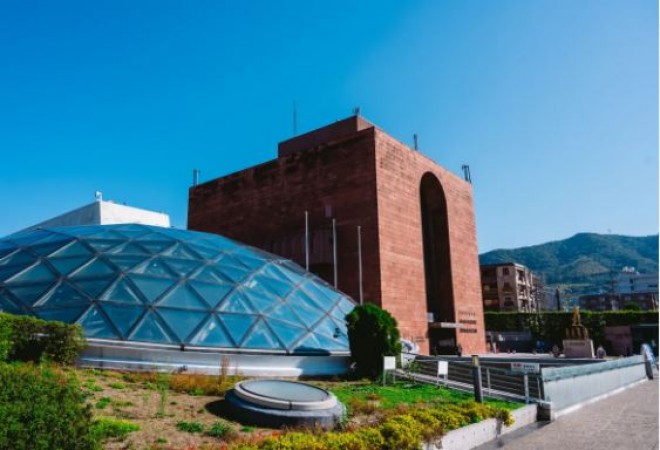
The Nagasaki Atomic Bomb Museum stands as a poignant reminder of one of the darkest days in human history. It is a solemn tribute to the victims of the devastating atomic bombing of Nagasaki, Japan, on August 9, 1945, during World War II. The museum serves not only as a memorial but also as a vital educational institution that aims to raise awareness about the horrors of nuclear warfare and promote global peace and disarmament.
Also Read: Sapporo: A Glimpse into Japan's Northern Beauty
During the final stages of World War II, the United States conducted a top-secret project known as the Manhattan Project. Its objective was to develop nuclear weapons, and on August 6, 1945, the first atomic bomb was dropped on Hiroshima, killing tens of thousands of people instantly. Just three days later, on August 9, 1945, a second atomic bomb, nicknamed "Fat Man," was dropped on Nagasaki, a city in southwestern Japan. This second attack resulted in the deaths of over 70,000 people, including immediate casualties and those who succumbed to radiation sickness in the aftermath.
The Nagasaki Atomic Bomb Museum was established in April 1996 to commemorate the 50th anniversary of the atomic bombing. Its creation was driven by a collective desire to preserve the memories of the tragic event and to ensure that the world would never forget the devastating consequences of nuclear warfare. The museum was built near the ground zero of the bomb's explosion, providing visitors with a chilling connection to the past.
Also Read: El Salvador: Unraveling the Journey of Progress and Challenges
The museum's exhibits are divided into several sections, each offering a comprehensive and emotionally powerful portrayal of the events surrounding the bombing and its aftermath. One of the prominent sections is the "Introduction Zone," which presents the historical context, the development of nuclear weapons, and Japan's role in the war. Visitors are offered insights into the decision-making process that led to the use of atomic bombs, raising ethical questions about the devastating power of these weapons.
The "Damage Zone" is another crucial part of the museum, displaying artifacts and photographs that vividly illustrate the destruction caused by the atomic bomb. These exhibits include remnants of buildings, clothing, personal belongings, and even items fused together by the intense heat of the explosion. Such artifacts provide a haunting reminder of the immense loss of life and the widespread devastation caused by the bomb's detonation.
Also Read: The Groote Kerk: Oldest Church of South Africa
The "Pledge Zone" is perhaps the most emotionally charged section of the museum. It houses letters, drawings, and messages of peace from survivors (hibakusha), expressing their hopes and prayers for a world free from nuclear weapons. This zone serves as a powerful testament to the resilience of the human spirit and the unwavering commitment to peace, even in the face of unimaginable suffering.
The Nagasaki Atomic Bomb Museum is not merely a place of remembrance but also a vital educational institution. It plays a significant role in educating visitors, especially the younger generations, about the devastating consequences of nuclear warfare. Through powerful exhibits and guided tours, the museum fosters an understanding of the horrors of war and the importance of working towards a world without nuclear weapons.
Also Read: Barbados: A Caribbean Paradise of Rich Culture and Stunning Beauty
Moreover, the museum actively advocates for peace and disarmament. It hosts conferences, seminars, and events that promote dialogue among nations, encouraging them to work together to prevent the use of nuclear weapons and to promote non-proliferation efforts. The museum's mission extends beyond Japan's borders, as it seeks to engage with international visitors and foster a global commitment to peace.
The Nagasaki Atomic Bomb Museum leaves a profound impact on visitors from all walks of life. For many, it is an emotionally overwhelming experience that fosters empathy and compassion for the victims and survivors of the atomic bombing. The personal stories shared by hibakusha create a deep connection with the past, driving home the message that such a tragedy should never be repeated.
Also Read: Kobe, Japan: A Vibrant City of Rich History and Modern Marvels
Visitors often leave the museum with a renewed commitment to advocating for peace and nuclear disarmament. They become ambassadors of the museum's message, sharing their experiences with others and working to create a world where nuclear weapons are eliminated. The museum's impact extends far beyond the walls of its building, as its visitors carry its lessons and values back to their communities and nations.
The Nagasaki Atomic Bomb Museum stands as a powerful symbol of remembrance, education, and advocacy for peace. Through its exhibits and artifacts, it offers a somber reflection on the tragic consequences of nuclear warfare and the importance of ensuring that such atrocities never happen again. The museum's mission to promote peace and disarmament serves as a testament to the resilience of the human spirit and the collective effort to create a world free from the threat of nuclear weapons. As we move forward, it is vital to preserve the memories of the past and embrace the lessons of the Nagasaki Atomic Bomb Museum to shape a more peaceful and secure future for all of humanity.
Also Read: Timeless Treasures: Exploring the Seven Great Temples of Nara, Japan's Ancient Heritage